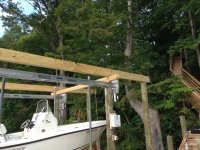s219
Super Member
- Joined
- Dec 7, 2011
- Messages
- 8,548
- Location
- Virginia USA
- Tractor
- Kubota L3200, Deere X380, Kubota RTV-X

I am in the process of putting a roof over my boat slip, and have just finished framing the side header beams (was a real project since the pilings are not straight nor in a perfect line). I'm about to start cutting rafters, and am thinking forward to the roof sheathing.
Some nearby neighbors have used OSB for their roof sheathing, but I am not real comfortable with that since the underside will be open to below, and sitting right above the water. That can't be good for OSB even though it's technically out of the weather. Another option is regular plywood at about twice the cost of OSB, and then pressure treated plywood (1/2" thickness) at another 2X cost (roughly $31 per sheet).
I wonder if anyone has used pressure treated plywood for roof sheathing before, and has feedback? This situation isn't that different than an open pole barn, so I imagine someone has thought about this before. One of my concerns with pressure treated is fasteners. I have galvanized nails for my gun to nail the sheathing down to the rafters, but I am not sure about roofing nails. They are normally zinc electroplated, but that isn't in the same league as galvanized nails. I'd hate to discover all the roofing nails corroding in a couple years and letting my shingles fly off!
I have also considered a metal roof, but feel like sheathing and shingles makes more sense working over the water where my access is limited. I am pretty sure I will make more progress nailing down shingles than driving a zillion screws around the more delicate sheet metal.
I'd appreciate any feedback you good folks can offer!
